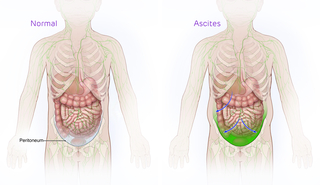What is ascites?
Ascites is a buildup of fluid in the abdomen. When it’s severe, ascites can cause stomach swelling (distention), abdominal pain, and difficulty breathing and eating.
There are several kinds of ascites. Two common forms are caused by liver cirrhosis (liver disease), or certain cancers of the abdomen. When the buildup of fluid contains chyle (a milky fluid that’s a combination of lymphatic fluid and fat), this form of ascites is known as chylous ascites and is a lymphatic flow disorder.
The lymphatic system plays a crucial role in immune function and in the delivery of vital nutrients to the body. Functioning almost like a sponge, the lymphatic system absorbs excess lymph fluid — watery fluid containing protein, electrolytes, cells and other substances — from the body’s organs and returns it to the blood stream. Injury to lymphatic vessels, congenital abnormalities or excessively high venous pressures can result in lymphatic flow problems and leakage of lymphatic fluid into the peritoneum leading to ascites.
In a healthy body, the lymphatic channels from the liver and mesentery drain toward the thoracic duct, which is the main lymphatic vessel responsible for lymph drainage. In children and adults with ascites, however, channels originating in the intestine or in the liver begin to flow in the opposite direction, creating leaks in the peritoneum. As lymphatic fluid spills in, there is no way for the body to absorb it.

What causes ascites?
Experts in the Jill and Mark Fishman Center for Lymphatic Disorders at Children’s Hospital of Philadelphia (CHOP) are leaders in lymphatic research, diagnostics and treatment. This research is changing the way the scientific and medical communities think about ascites. Ascites can be caused by primary and secondary disorders. Regardless of the cause, our imaging has shown that lymphatic leaks can be localized or diffuse leading to ascites. There are several non-lymphatic causes of ascites as well including cirrhosis and cancer that would require other forms of treatment.
Primary Ascites
Intestinal Lymphangiectasia (Disordered lymphatic flow)
- Poor mesenteric efferent lymphatic flow
- Poor hepatic efferent lymphatic flow
- Aberrant hepatoperitoneal connections
- Aberrant mesenteric-peritoneal connections
Lymphatic Channel Disorders (Lymphatic malformations)
- RASopathies
- Central conducting lymphatic anomaly (CCLA)
- Lymphangiomatosis/Generalized lymphatic anomaly (GLA)
- Kaposiform lymphatic anomaly (KLA)
- Gorham-Stout disease (GSD)
Secondary Ascites
Mechanical Obstruction
- Elevated central venous pressure (CVP)
- Elevated intrathoracic pressure (ITP)
- Obstructing tumors or masses
- Thoracic duct (TD) occlusion
What are the signs and symptoms of ascites?
Initially, ascites causes few symptoms. When enough fluid accumulates, though, affected individuals will have either abdominal swelling or distention, abdominal pain, nausea, vomiting, difficulty breathing or eating.
Sometimes, fluid from the abdomen can travel through openings in the diaphragm and lead to accumulation of fluid in the chest. When this happens, it can cause breathing difficulties.
How is ascites diagnosed?
Doctors use a combination of imaging tests to diagnose ascites. Tests may include X-ray, CT, ultrasound or MRI. A diagnosis of ascites is made when these tests demonstrate the presence of fluid in the peritoneal spaces.
Your doctor may also use a thin needle to withdraw some of the accumulated fluid. The fluid can then be tested for lymphocyte count and triglycerides to determine whether it is lymphatic in nature or not.
The world-renowned experts in the Jill and Mark Fishman Center for Lymphatic Disorders developed a specialized imaging technique - dynamic contrast magnetic resonance lymphangiography (DCMRL) - that is used to pinpoint the exact source of lymphatic leaks.
During this procedure, an MRI contrast agent (a safe, injectable dye) is injected directly into the lymphatic system and tracked by MRI.
There are three points of access through which the contrast agent is injected:
- Intranodal (inguinal lymph nodes)
- Intrahepatic (liver)
- Intramesenteric (mesentery)
Each point of access for DCMRL provides a different view of the lymphatic system for the most comprehensive lymphatic imaging. Patients with ascites may receive all three points of access, allowing our physicians to clearly see the anatomy of the lymphatic system, the direction and speed of lymphatic flow and the exact source of any leaks. This is especially important in ascites diagnosis and treatment to identify the source of leak and to target an intervention.
How is ascites treated?
Treatment of ascites depends on its cause. At the Jill and Mark Fishman Center for Lymphatic Disorders, patients are treated by a team of experts who specialize in lymphatic imaging and interventions. The team will determine the best treatment approach for each patient’s condition.
In all patients, the first step involves careful mapping of the anatomy and flow of the lymphatic system. This is done using a specialized MRI technique called dynamic contrast MR lymphangiography. During this procedure, an MRI contrast agent is injected directly into the lymphatic system.
After the MRI procedure a small catheter is placed into the main lymphatic channel, called the thoracic duct, to determine if it is connected to the vein and draining appropriately. Next, a small catheter is placed into the lymphatic channels in the abdomen to better assess the channels leading to ascites.
After the abnormal channels are identified, they are sealed using a procedure called selective lymphatic duct embolization. Your or your child’s doctor will use oil, coils, particles, glue or other bonding agents, inserted through a tiny tube (catheter), to seal the ducts.
With this procedure, and all procedures we do, we are careful not to block the main thoracic duct if possible, an approach that experts at CHOP believe is important for the success of this procedure. Because lymphangiography allows clinicians to pinpoint the exact spot of the leak, they can target their intervention to the affected area, preserving the thoracic duct.
The treatment of ascites in patients with heart disease may also include cardiac interventional procedures such as balloon dilation, stent dilation of a narrow vessel, or embolization of an abnormal blood vessel with coils.
You or your child may also be prescribed medications that can lower venous pressures and maintain a low fat diet.
Long-term outlook for ascites
The long-term outlook for patients with ascites varies. Many patients who have chylous ascites caused by trauma to the central lymphatic system can be cured.
Treating patients whose ascites is caused by conditions such as liver disease, conduction disorders and heart failure, though, can be more challenging. However, experts at the Lymphatic Center are currently developing new imaging and treatment options for these patients.
Follow-up care
Most of the follow-up care will be provided by your or your child’s primary physician in coordination with the team at the Jill and Mark Fishman Center for Lymphatic Disorders. This can include recommendations for new medications, medication weans or diet recommendations.
Research
Experts are collaborating on research to better understand the lymphatic system, develop new lymphatic interventional procedures, and to improve lymphatic imaging modalities.
Our Publications
Pablo Laje, Yoav Dori, Christopher Smith, Katsuhide Maeda. Surgical management of chronic lymphatic pleural effusions and chronic lymphatic ascites. Seminars in Pediatric Surgery. Volume 33, Issue 3. 2024. 151420, ISSN 1055-8586.
Abhay Srinivasan, Christopher L. Smith, Yoav Dori, Ganesh Krishnamurthy. Percutaneous procedures for central lymphatic conduction disorders. Seminars in Pediatric Surgery. Volume 33, Issue 3. 2024. 151418, ISSN 1055-8586.
Khan S, Smith CL, Pinto EM, Taha DK, Gibbs KA, Rosenblatt SA, Dori Y. Effect of positive pressure ventilation on lymphatic flow in pediatric patients. J Perinatol. 2022 Nov 25. doi: 10.1038/s41372-022-01563-7. Epub ahead of print. PMID: 36434049
Why choose us
Our team has one of the largest experiences in the world in treating both children and adults with ascites. We have developed a variety of innovative imaging and interventional techniques that have advanced the minimally invasive treatment options available to patients.
Treatment for ascites
Treatment of ascites depends on its cause. At the Jill and Mark Fishman Center for Lymphatic Disorders, patients are treated by a team of experts who specialize in lymphatic imaging and interventions. The team will determine the best treatment approach for each patient’s condition.
When lymphatic imaging is able to identify the source of the leak that is causing ascites, the source can be sealed during an embolization procedure.
Long-term outlook for ascites
The long-term outlook for patients with ascites varies. Many patients who have chylous ascites caused by trauma to the central lymphatic system can be cured.
Treating patients whose ascites is caused by conditions such as liver disease and heart failure, though, can be more challenging. However, experts at the Lymphatic Center are currently developing new imaging and treatment options for these patients.
Follow-up care
Most of the follow-up care will be provided by your or your child’s primary physician in coordination with the team at the Jill and Mark Fishman Center for Lymphatic Disorders. This can include recommendations for new medications, medication weans or diet recommendations.
Research
Experts are collaborating on research to better understand the lymphatic system, develop new lymphatic interventional procedures, and to improve lymphatic imaging modalities.
Why choose us
Our team has one of the largest experiences in the world in treating both children and adults with ascites. We have developed a variety of innovative imaging and interventional techniques that have advanced the minimally invasive treatment options available to patients.
Resources to help
Jill and Mark Fishman Center for Lymphatic Disorders Resources
We know that caring for a child with a health condition can be stressful. To help you find answers to your questions and feel confident in the care you're providing your child, we’ve created this list of educational health resources.
Reviewed by Yoav Dori, MD, PhD
